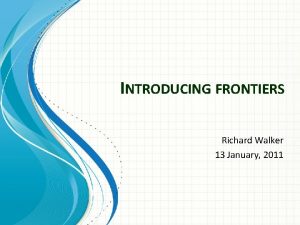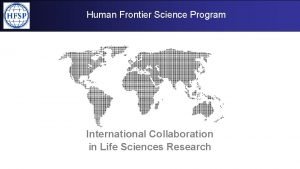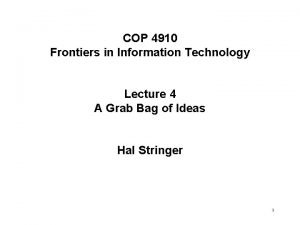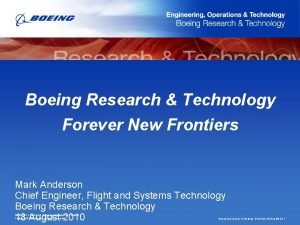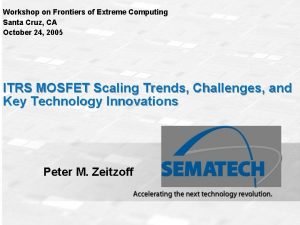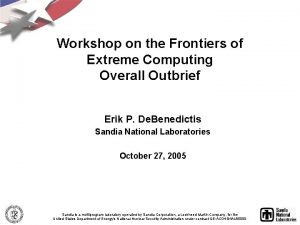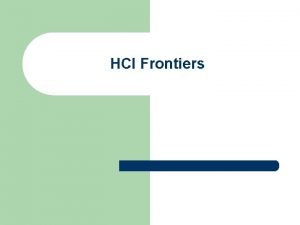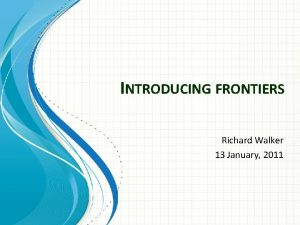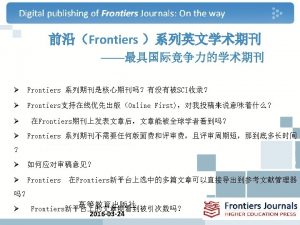Workshop on the Frontiers of Extreme Computing Erik









- Slides: 9

Workshop on the Frontiers of Extreme Computing Erik P. De. Benedictis Sandia National Laboratories October 24 -27, 2005 Sandia is a multiprogram laboratory operated by Sandia Corporation, a Lockheed Martin Company, for the United States Department of Energy's National Nuclear Security Administration under contract DE-AC 04 -94 AL 85000.

Issues • The 1994 meeting looked to the future – 100 Gigaflops 10, 000 1 Petaflops • By contrast, this meeting has no numerical target – We have full range of applications represented • FLOPS + (some) non-FLOPS – We have hardware represented that can run the software, creating a balance • Drama: we have a “phase change” in the realm at – 100 Petaflops for $100 M leadership class supercomputer or – 1 Petaflops for $1 M university class supercomputer

Applications and $100 M Supercomputers System Performance Applications Plasma Fusion Simulation 1 Zettaflops Jardin Tue 9: 30 100 Exaflops 1 Exaflops , , and Quantum Computing on another slide; also Fredkin banquet Tue 7 No schedule provided by source Reversible Logic limits Bennett Mon 10 Full Global Climate Frank Mon 1: 30, Lent Tue Bader Mon 9 MEMS 1: 30, Niemier, Tue 2 Optimize NASA Computing needs Biswas Wed 9: 30 100 Petaflops 100 Teraflops 2000 Technology Architecture limit Burger Mon 11: 30 SCa. Le. S Keyes Tue 9 2010 2020 2000 Transistorized m. P limit Zeitzoff Mon 11 2010 2020 2030 Year

Emergence of Quantum Computing ZFLOPS O pt im ist ic: 10 0 FL O PS +3 x/ ye ar • Oskin Wed 2 PM has a re” u t c ite h paper on how to build a EFLOPS c r ed A c n tion a 1 FLOPS QC c e j o PFLOPS “Adv r Pr e t s – delivery date unstated Clu ar e y TFLOPS / • One would expect an 2 x + PS exponential growth rate O GFLOPS FL 0 for quantum computers : 1 0 0 similar to Moore’s Law, MFLOPS p 5 o ar T x/ye 3. 1 + but the rate constant is OPS L F w: 1 a impossible to predict, KFLOPS L s re’ Moo so three possibilities FLOPS have been graphed 2000 2010 2020 2030 Note: I don’t have anything to say about when the first practical QC will be built. This will not affect the argument. Hence “cloud. ” Ref. “An Evaluation Framework and Instruction Set Architecture for Ion-Trap based Quantum Micro-architectures, ” Steven Balensiefer, Lucas Kregor-Stickles, and Mark Oski, University of Washington “How to build a 300 bit, 1 Gop quantum computer, ” Andrew M. Steane, Clarendon Laboratory, UK, quant-ph/0412165 2040 2050

Sp Qua se eed dra arc up tic hin Gr g a ove lgo r’s rith m Exponential Speedup Cryptanalysis Phy. Simulation Quantum Applications ZFLOPS • Consider the classical re” u t c ite h computer equivalent to EFLOPS c r ed A c n tion a a Quantum Computer PFLOPS c v e j d o “A r Pr e t s • Williams Wed 2: 30 will Clu TFLOPS discuss physical simulations with GFLOPS exponential speedup over classical (blue) MFLOPS • Searching algorithms broadly parallelize loops. KFLOPS and can achieve quadratic speedup over FLOPS a classical computer 2000 2010 2020 2030 2040 2050

Hardware Questions • Evolutionary Trends – What can we expect from transistors, nanotech, & superconducting in current class of computation? • Drive Current Computing Class to Maturity – How can we optimize architectures (mostly for power) in order to get a final 100 performance boost before flat lining? • Move to the Next Computing Class – Should reversible logic and/or quantum computing be considered for the mainstream?

Applications and Software Questions • Applications – How strong is the case for building big computers to solve important problems? – Can we better synchronize hardware roadmaps with applications plans • Software – ALL classical (nonquantum) computing options involve dramatic increase in parallelism – There is virtually nobody looking into how algorithms and programming – Other issues

ITRS Emerging Research Devices (2004) • Seeks research options for long term continuation of Moore’s Law • Table created by tallying votes of a committee of industry “experts. ” • Color codes, likely, possible, unacceptable

Emerging Research Devices (notes 2005) • Notes from 2005 meeting • Immediate implication: all devices unacceptable except CNFET • However CNFET is a short term solution, and belongs on a different table




